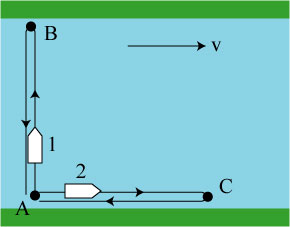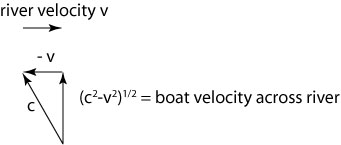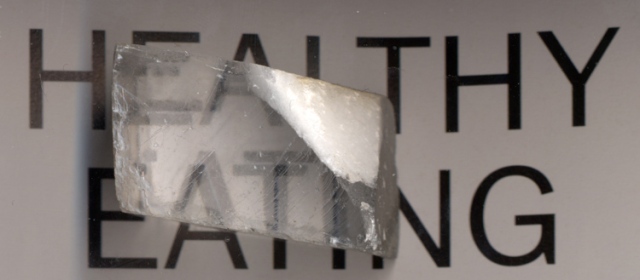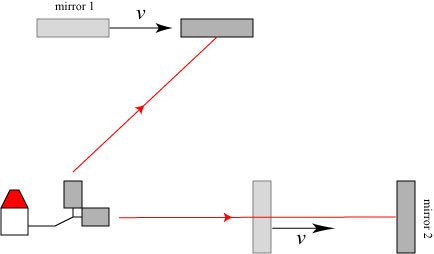(Note: This is an attempt to get myself rolling on my long-ignored series of posts explaining Einstein’s theories of relativity. It’s also a really cool experiment in the history of science.)
One of the most fascinating aspects of 19th century physics is that many remarkable ideas and ingenious experiments were motivated by a physical hypothesis which we now know to be incorrect: namely, the aether. When light was demonstrated to have wavelike properties in the early 1800s, it was natural to reason that, like other types of waves, light must result from the excitation of some medium: after all, water waves arise from the oscillations of water, sound waves arise from the oscillation of air, and string vibrations are of course the oscillations of string. The hypothetical medium which carries light vibrations was dubbed the “aether”, due to its unknown, “aetherial” nature.
A lot of scientists speculated on the physical properties of the aether, and sometimes this speculation produced lasting results in other fields; for instance, Earnshaw’s theorem was originally conceived to try and describe the forces involved in the aether’s oscillation.
By the late 1800s, however, more and more research cast doubt on the very existence of the aether, notably the Michelson-Morley experiment (to be discussed below). In response, theoreticians produced more and more “patches” to the aether theory, until at last Einstein published his special theory of relativity, which eliminated the need for an aether and in fact suggested that the idea of an aether was incompatible with the experimental evidence.
Before this happened, however, at least one brilliant researcher took up the challenge of testing one of the “patches” to the aether. Lord Rayleigh (1842-1919), distinguished physicist and eventual Nobel Prize winner, conceived of and carried out a very clever optical experiment to see whether objects shrink in the direction of motion, a phenomenon known as length contraction.
As is often the case, even though the experiment was unsuccessful, we can still learn many useful lessons about the workings of science from it!
To understand the experiment, we need to discuss first the 1887 Michelson-Morley experiment and the questions that it raised about the nature of the aether. I’ve discussed this in some detail in a previous post; here we review the essentials.
By the 1880s, the aether was pretty much as mysterious as it had been when first postulated, as no experiments had directly detected its existence. By analogy with sound waves, however, it was assumed that the speed of light m/s was fixed with respect to the aether. That is, an observer at rest in the aether would see all light waves traveling at
, but observers in motion would measure different speeds for light, depending on their motion relative to the light. For instance, according to Newtonian relativity, an observer moving at velocity v parallel to a beam of light would measure the speed of the light beam as
, while an observer moving at velocity v antiparallel to the beam would measure its speed as
.
The Earth was known to be traveling at 30 km/s in its path around the Sun, which meant that at some point in its motion it had to be traveling at least 30 km/s with respect to the underlying aether. This suggested that the speed of light along the direction of Earth’s motion would be different than the speed of light perpendicular to the direction of Earth’s motion.
In 1887, Albert Michelson and Edward Morley refined an ingenious optical experiment to measure this difference. They used a device known now as a Michelson interferometer, shown in simplified form below:

A light beam is incident from the left. It hits a half-silvered mirror which is inclined at a 45 degree angle, which splits the beam into two parts: one which is reflected, one of which is transmitted. Each fraction of the beam travels to a mirror and back, and at the half-silvered mirror they are recombined and their sum is projected onto a screen. Because the light has traveled a different distance in each arm of the interferometer, we get an interference pattern on the screen.
To understand how such an interferometer allows, in theory, one to detect relative motion with respect to the aether, we make an analogy between light traveling in the two arms of the interferometer and boats traveling on different paths on a river:

Each boat has a top speed of , and the river flows to the right with velocity
. Boat 1 travels a distance
from point A to point B, and then returns, while boat 2 travels a distance
from point A to point C, and then returns. How long does it take each boat to return to the starting point? We can use a little geometry and velocity addition to determine this. Boat 2 will have a total velocity of
on the way out to point C, and will have a total velocity
on the way back. Boat 1’s velocity is slightly more difficult to calculate; in order to travel straight across the river, it must have a velocity
against the river flow, and a total velocity of
. Using some simple geometry,

boat 1 must have a speed moving from A to B, and an identical speed for the return trip. We therefore find that the transit times for the boats are as follows:
,
.
The two times are different! In principle, this difference manifests itself in the position of interference fringes in the output of the interferometer. If the interferometer is rotated 90°, the roles of the two interferometer arms are reversed, and the fringes should visibly shift in position.
Surprisingly, no shift in the fringes was observed by Michelson and Morley. Their experimental apparatus was sensitive enough to detect the known motion of the Earth within the aether, and utterly failed to do so. None of the theories of the aether at the time could explain this absence of relative motion without contradiction.
A possible solution to the conundrum was suggested independently in a short letter1 by George Fitzgerald in 1889 and in more detail2 in 1895 by Hendrik Lorentz. It is worth quoting Fitzgerald’s letter in its entirety to explain the effect:
I HAVE read with much interest Messrs. Michelson and Morley’s wonderfully delicate experiment attempting to decide the important question as to how far the ether is carried along by the earth. Their result seems opposed to other experiments showing that the ether in the air can be carried along only to an inappreciable extent. I would suggest that almost the only hypothesis that can reconcile this opposition is that the length of material bodies changes, according as they are moving through the ether or across it, by an amount depending on the square of the ratio of their velocity to that of light. We know that electric forces are affected by the motion of the electrified bodies relative to the ether, and it seems a not improbable supposition that the molecular forces are affected by the motion, and that the size of a body alters consequently. It would be very important if secular experiments on electrical attractions between permanently electrified bodies, such as in a very delicate quadrant electrometer, were instituted in some of the equatorial parts of the earth to observe whether there is any diurnal and annual variation of attraction, — diurnal due to the rotation of the earth being added and subtracted from its orbital velocity; and annual similarly for its orbital velocity and the motion of the solar system.
In short: suppose that an object moving in the aether shrinks along the direction of motion, as illustrated below:
One can readily determine the amount of contraction necessary to give a null result for the Michelson Morley experiment; suppose the distance that boat 2 moves, with/against the river flow, is contracted to a new length
.
Then the time delay that would be experienced by boat 2 in its round trip would be
.
This would be exactly the time delay experienced by boat 1, as well, and no difference between the boats’ travel times would be observed.
In the case of the Michelson Morley experiment, the “shrinkage” in the length of the interferometer in the direction of motion would be ridiculously small, assuming km/s and
m/s:
.
In other words, if the arm of the interferometer was a meter long, the overall length of the interferometer would change by 10 nanometers, an almost negligible amount.
It is hard not to view the contraction hypothesis as a bit of an ad hoc “patch” to the theory of the aether, though Lorentz himself apparently viewed it as the only possible conclusion from the experimental results. He even gave a plausibility argument concerning it (translation from Larmor’s Aether and Matter, 1900):
However extraordinary this hypothesis may appear at first sight, it must be admitted that it is by no means gratuitous, if we assume that the intermolecular forces act through the mediation of the aether in a manner similar to that which we know to be the case in regard to electric and magnetic forces. If that is so, the translation of the matter will most likely alter the action between two molecules or atoms in a manner similar to that in which it alters the attraction or repulsion between electrically charged particles. As then the form and the dimensions of a solid body are determined in the last resort by the intensity of the molecular forces, an alteration of the dimensions cannot well be left out of consideration.
I had always assumed that the contraction effect was much too small for anyone to consider measuring in Lorentz’s time. In 1902, however, Lord Rayleigh suggested that the contraction effect might actually manifest itself through the phenomenon of double refraction — and he proceeded to test his hypothesis3!
Double refraction, also known as birefringence, occurs when light passes through a material such as a crystal which has an anisotropic structure, i.e. light of one polarization ‘sees’ a different structure than light of a perpendicular polarization. More quantitatively, light of one polarization passes through a material faster than light of another polarization. In materials such as calcite this results in the appearance of ‘twin’ images (via Wikipedia):
If polarized light is passed through a birefringent material, the direction of polarization is rotated
Rayleigh realized that length contraction would by its nature make a material birefringent, as illustrated below:
Light traveling perpendicular to the direction of motion will ‘see’ two different spacings of the atoms in the material; light x-polarized will see a smaller atomic spacing than light which is y-polarized.
A schematic of Rayleigh’s experiment is shown below. Because it is difficult to present polarization changes in a figure with perspective, I also illustrate the ‘head on’ view of the important elements:
Unpolarized light is produced and focused onto a Nicol polarizer, which produces a polarized beam of light oriented 45º to the vertical. Ignoring the strained glass for a moment, the light enters the liquid sample. Provided the motion of the Earth is perpendicular to the direction of light propagation, one would expect length contraction-induced birefringence to rotate the direction of polarization. Light then passes through an “analyzing” Nicol prism.
In the ideal situation, one would orient the analyzing prism until it completely extinguishes the polarized light. By comparing the orientation of the two Nicol prisms, one could see if the state of polarization rotates. This is a dubious comparison, however, because other factors, such as a natural birefringence of the liquid chamber, might perform an indistinguishable rotation. To distinguish between the two cases, Rayleigh fixed his experimental apparatus to a turnable platform. Because length contraction-induced birefringence would be expected to depend significantly upon the orientation of the experiment, any changes in birefringence upon changing the orientation would be a sign of the effect.
To make any changes easier to observe, Rayleigh placed a piece of strained glass between the first polarizer and the liquid chamber. The strained glass has its own natural birefringence, which results in an interference pattern at the output of the experiment. Changes in birefringence (presumably due to length contraction) could be easily seen as shifts in the position of the interference pattern.
Rayleigh searched for length contraction-induced birefringence in bisulphide of carbon and in water. As we would expect, he found no such contraction, even though his device was in principle sensitive to length variations of a tenth of a nanometer, a factor of a hundred more sensitive than needed to detect the effect. Being a very good scientist, Rayleigh did not shy away from pointing out potential weaknesses in his own analysis,
So far as liquids are concerned, the experiment is of no great difficulty, and the conclusion may be stated that there is no double refraction of the order to be expected, that is comparable with
of the single refraction. But the question arises whether experiments upon liquids really settle the matter. Probably no complete answer can be given, unless in the light of some particular theory of these relations. But it may be remarked that the liquid condition is no obstacle to the development of double refraction under electric stress, as is shown in Dr. Kerr’s experiments.
In other words, it is natural to wonder whether liquids might slosh about in such a way that the double refraction effects do not appear. This is a reasonable concern, but Rayleigh notes that double refraction is achievable in liquids via electrical forces, namely through the Kerr effect. Rayleigh furthermore noted attempts to repeat the experiments in solids, and he again found negative results, though less accurate ones.
Einstein’s relativity was published in 1905, only a few years after Rayleigh’s experiments, and the new theory could account for them quite succinctly. In special relativity, the laws of physics, including the speed of light, are the same in every inertial reference frame (i.e. for every observer moving at constant velocity). According to an observer in the laboratory, the speed of light in each arm of the Michelson interferometer is simply , regardless of how the Earth moves relative to its neighbors; the notion of “length contraction induced by aether” is unnecessary. There is no “aether” which light propagates in, so there is no “relative velocity with respect to the aether” to be measured.
Curiously, though, length contraction does make an appearance in special relativity, but it is a much more subtle effect than that which appears in Lorentz’s initial theory. Let us imagine a modified version of the Michelson interferometer, which fires simultaneously two ultrashort pulses each of which propagates a distance to a mirror and returns to a detector at the point of origin5. If both pulses arrive at the same time, a siren goes off to unambiguously announce their simultaneous arrival. From the point of view (“reference frame”) of the laboratory, each pulse travels the same distance at the speed of light
and returns, firing off the siren.
Now let us consider this from the point of view of an observer who is traveling at velocity relative to the experiment along a line antiparallel to the path towards mirror 2. From the observer’s point of view, the experiment is moving to the right at velocity
:
The moving observer sees the light heading towards mirror 1 on a diagonal trajectory, and the light heading towards mirror 2 must chase the moving mirror, taking longer to reach it. On the way back, the light returning from mirror 1 also follows a diagonal trajectory, and the light returning from mirror 2 has the detector moving towards it at velocity . According to Einstein’s relativity, however, and distinct from the aether/boat case above, the moving observer measures the velocity of light to be
for the light moving along both paths!
Let us assume that the physical separation, according to the observer, between detector and mirror 1 is , and the separation between detector and mirror 2 is
. With geometry, we can show that the total distance the light travels on a round trip from mirror 1 is:
,
while the total distance the light travels on a round trip from mirror 2 is:
.
Because the siren goes off, we know that the light from the two paths arrives back at the detector simultaneously, which means they must have traveled the same distance. Because the speed of light is the same for both cases, this implies that
,
which is exactly the formula of Lorentz contraction!
Though the formulas are superficially the same, the interpretation of the physics in the Einstein case and the Lorentz case are dramatically different. Both interpretations result in the observation that changes in the speed of light cannot be measured with the Michelson interferometer; however, the means by which this invariance is achieved are quite different. The Lorentz interpretation says that a laboratory observer could in principle physically measure the shrinking of his apparatus due to relative motion with the aether; this is what Rayleigh tried, and failed, to measure. The Einstein interpretation says that the laboratory observer sees no measurable shrinkage of his device, but an observer moving past the experimental setup will observe the shrinkage.
Lots of anti-relativity “crackpots” like to trumpet the idea that Lorentz’s relativistic formulation is equally valid to Einstein’s. Experiments like Rayleigh’s, however, highlight that, at least in its earliest form, Lorentz’s relativistic aether theory had measurable experimental differences with the Einstein theory, and those tests which were performed in fact failed. If you ever have to argue with a relativity denialist about the existence of an aether and “Lorentzian relativity”, keep this post in mind!
There are a lot of subtle points to digest in the above discussion, and a lot of Einstein’s relativity which has been more or less left out for the purposes of brevity6. I’ll come back to a detailed analysis of Einstein’s relativity theory in future posts.
************************
1 G. Fitzgerald, “The Ether and the Earth’s atmosphere,” Science 13 (1889), 390.
2 H. Lorentz, “Versuch einer Theorie der electrischen und optischen Erscheinungen in bewegten Körpern” (Leiden, 1895).
3 Lord Rayleigh, “Does motion through the Æther cause double refraction?” Phil. Mag. 4, sixth series (1902), 678-683.
4 We give a somewhat unconventional explanation here, which allows us to compare the results with the already-discussed expectations of the aether. A more concise explanation will be given in a future post, when I formulate Einstein’s relativity and its consequences rigorously.
5 This point is important. In Einstein’s relativity, events which are simultaneous but spatially separated in one reference frame are not necessarily simultaneous in another reference frame. If the two pulses arrive at the same point at the same time in one frame, however, they do so in all frames.
6 And the post is still too darn long!








6 And the post is still too darn long!
No it isn’t!
thony: Thanks for contradicting me! I certainly seemed long while I was struggling to write it! 🙂
This is definitely a post I’ll be linking in an overlong one of mine currently in work.
It is long but it’s not too long 😉
I was not aware that Lord Rayleigh had done an experiment inwhich no contraction occurred, very interesting.
Michelson-Morley failed to show a shift because there is no aether wind on the surface of planet earth – the aether is present as our atmosphere and is carried along with us as the magnetosphere.
Interesting stuff, thanks.
Best Wishes from Rayleigh, Essex!
If one finds the post too long, then one is not reading is fast enough to make it short. 😉
Now how could I argue with that? 😉
Pingback: The Giant’s Shoulders #13: A day at the fair! | Skulls in the Stars
As I understand it, the discussion of effects of birefringence on polarization are somewhat misleading, since it doesn’t rotate the plane of a linear polarization, but rather reflects it over time (rotating would require the normal and abnormal components to vary in amplitude with no relative phase change, but they do exactly the opposite: keep the amplitude but their phases drift apart). It might be a point not relevant enough to go into details in the post, but right now it does strongly suggest a misleading reading, so maybe some footnotes/disclaimers could be of help…
PS, viewing ice chunks through crossed polarizers is amazing because of this effect, it’s like a dynamic mosaic, recommend to try for youself)